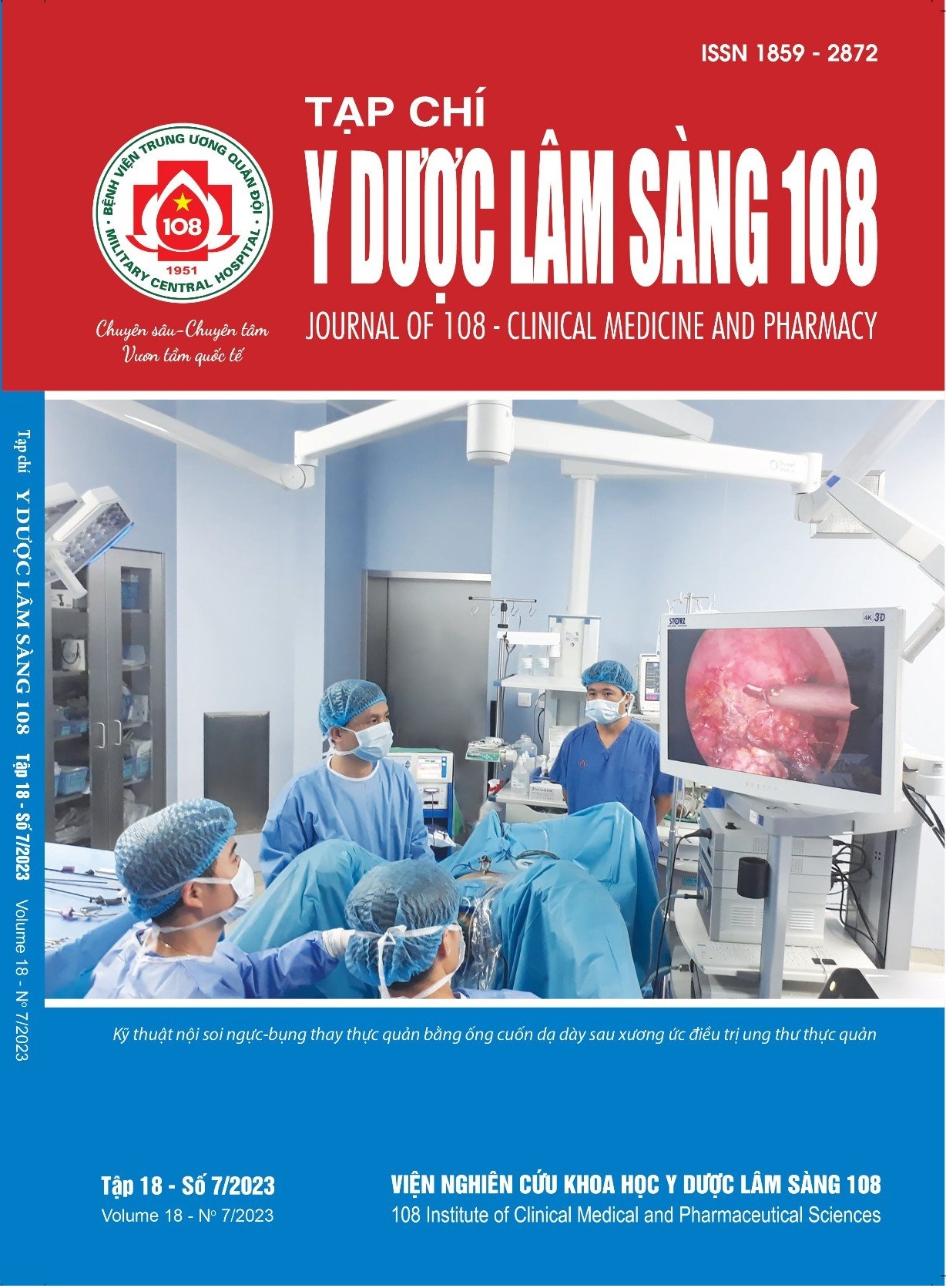Đánh giá một số đặc điểm lâm sàng, cận lâm sàng và yếu tố nguy cơ ở bệnh nhân động kinh muộn sau đột quỵ trên lều
Main Article Content
Keywords
Tóm tắt
Mục tiêu: Mô tả đặc điểm lâm sàng, cận lâm sàng và một số yếu tố liên quan đến cơn động kinh muộn của đột quỵ não trên lều. Đối tượng và phương pháp: Nghiên cứu tiến cứu trên 1061 bệnh nhân đột quỵ não trên lều tại Bệnh viện Trung ương Quân đội 108 và Bệnh viện Đa khoa tỉnh Phú Thọ từ 2018 đến 2022. Khám lâm sàng, cận lâm sàng và theo dõi bệnh nhân sau ra viện cho đến 01/2023. Kết quả: Có 41/1061 (3,86%) bệnh nhân đột quỵ não trên lều có cơn động kinh muộn, khởi phát cơn động kinh vận động 40/41 trường hợp (97,7%) và 23 trường hợp (56,1%) là cơn toàn thể. Tuổi trung bình là 63,8 ± 10,9 tuổi, nam giới chiếm 73,2%. Điểm Glasgow trung bình là 14 ± 1,9, NIHSS là 6,7 ± 4,8. CT-MRI ghi nhận 48,8% là tổn thương bán cầu não phải, trong đó tổn thương vùng dưới vỏ là 56,1%, nhiều nhất là thùy đỉnh 80,5%. 85,4% là thể nhồi máu và thuộc 1 vùng cấp máu động mạch não chiếm 63,4%. Điện não đồ video phát hiện 10/41 (24,4%) trường hợp có bất thường, chủ yếu là sóng nhọn 8/41 (19,5%), hay gặp là thùy đỉnh và thùy thái dương 9/41 (22%). Yếu tố liên quan đến cơn động kinh muộn là tuổi cao, tiền sử rối loạn nhịp tim, tiền sử đột quỵ não cũ, nhồi máu não, tổn thương một vùng động mạch. Kết luận: Cơn động kinh muộn sau đột quỵ có khởi phát vận động, kiểu toàn thể. Yếu tố liên quan là: Tuổi cao, tiền sử rối loạn nhịp tim, đột quỵ cũ, nhồi máu não.
Article Details
Các tài liệu tham khảo
2. Waafi AK, Husna M, Damayanti R & Setijowati N (2023) Clinical risk factors related to post-stroke epilepsy patients in Indonesia: a hospital-based study. The Egyptian Journal of Neurology, Psychiatry and Neurosurgery 59(39).
3. Agarwal A, Sharma J, Padma Srivastava MV, Bhatia R, Singh MB, Gupta A, Pandit AK, Singh R, Rajan R, Dwivedi S, Upadhyay A, Garg A, Vishnu VY (2021) Early post-stroke seizures in acute ischemic stroke: A prospective cohort study. Ann Indian Acad Neurol 24(4): 580-585.
4. Bladin CF, Alexandrov AV, Bellavance A, Bornstein N, Chambers B, Coté R, Lebrun L, Pirisi A, Norris JW (2000) Seizures after stroke: A prospective multicenter study. Archives of neurology 57(11): 1617-1622.
5. Chen TC, Chen YY, Cheng PY, Lai CH (2012) The incidence rate of post-stroke epilepsy: A 5-year follow-up study in Taiwan. Epilepsy research 102(3): 188-194.
6. Galovic M, Döhler N, Erdélyi-Canavese B, Felbecker A, Siebel P, Conrad J, Evers S, Winklehner M, von Oertzen TJ, Haring HP, Serafini A, Gregoraci G, Valente M, Janes F, Gigli GL, Keezer MR, Duncan JS, Sander JW, Koepp MJ, Tettenborn B (2018) Prediction of late seizures after ischaemic stroke with a novel prognostic model (the SeLECT score): A multivariable prediction model development and validation study. The Lancet Neurology 17(2): 143-152.
7. Graham NS, Crichton S, Koutroumanidis M, Wolfe CD, Rudd AG (2013) Incidence and associations of poststroke epilepsy: The prospective South London Stroke Register. Stroke 44(3): 605-611.
8. Guo X, Zhong R, Han Y, Zhang H, Zhang X, Lin W (2022) Incidence and relevant factors for seizures after spontaneous intracerebral hemorrhage: A systematic review and meta-analysis. Seizure 101: 30-38.
9. Gupta SR, Naheedy MH, Elias D, Rubino FA (1988) Postinfarction seizures. A clinical study. Stroke 19(12): 1477-1481.
10. Kammersgaard LP, Olsen TS (2005) Poststroke epilepsy in the Copenhagen stroke study: Incidence and predictors. Journal of Stroke and Cerebrovascular Diseases 14(5): 210-214.
11. Lahti AM, Saloheimo P, Huhtakangas J, Salminen H, Juvela S, Bode MK, Hillbom M, Tetri S (2017) Poststroke epilepsy in long-term survivors of primary intracerebral hemorrhage. Neurology 88(23): 2169-2175.
12. Ozon AO, Cüce F (2020) Clinical and radiological evaluation of epilepsy after ischemic cerebrovascular disease. Gulhane Med J 62:126-130.
13. Phan J, Ramos M, Soares T, Parmar MS (2022) Poststroke Seizure and Epilepsy: A review of incidence, risk factors, diagnosis, pathophysiology, and pharmacological therapies. Oxid Med Cell Longev: 7692215.
14. Sivaci A (2015) Correlation between lesion location and EEG findings in post-stroke epilepsy. EPILEPSI 21(1).
15. Wang G, Jia H, Chen C, Lang S, Liu X, Xia C, Sun Y, Zhang J (2013) Analysis of risk factors for first seizure after stroke in Chinese patients. BioMed research international.
16. Zou S, Wu X, Zhu B, Yu J, Yang B, Shi J (2015) The pooled incidence of post-stroke s eizure in 102 008 patients. Topics in stroke rehabilitation 22(6): 460-467.
 ISSN: 1859 - 2872
ISSN: 1859 - 2872
